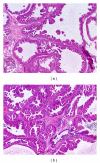Pathologic findings in MRI-guided needle core biopsies of the breast in patients with newly diagnosed breast cancer
- PMID: 22332013
- PMCID: PMC3276071
- DOI: 10.4061/2011/613285
Pathologic findings in MRI-guided needle core biopsies of the breast in patients with newly diagnosed breast cancer
Abstract
The role of MRI in the management of breast carcinoma is rapidly evolving from its initial use for specific indications only to a more widespread use on all women with newly diagnosed early stage breast cancer. However, there are many concerns that such widespread use is premature since detailed correlation of MRI findings with the underlying histopathology of the breast lesions is still evolving and clear evidence for improvements in management and overall prognosis of breast cancer patients evaluated by breast MRI after their initial cancer diagnosis is lacking. In this paper, we would like to bring attention to a benign lesion that is frequently present on MRI-guided breast biopsies performed on suspicious MRI findings in the affected breast of patients with a new diagnosis of breast carcinoma.
Figures

Similar articles
-
Outcome analysis of 9-gauge MRI-guided vacuum-assisted core needle breast biopsies.AJR Am J Roentgenol. 2012 Feb;198(2):292-9. doi: 10.2214/AJR.11.7594. AJR Am J Roentgenol. 2012. PMID: 22268171 Free PMC article.
-
Pathologic Findings of Breast Lesions Detected on Magnetic Resonance Imaging.Arch Pathol Lab Med. 2017 Nov;141(11):1513-1522. doi: 10.5858/arpa.2016-0552-OA. Epub 2017 Aug 7. Arch Pathol Lab Med. 2017. PMID: 28782985
-
Outcome of MRI-guided vacuum-assisted breast biopsy - initial experience at Institute of Oncology Ljubljana, Slovenia.Radiol Oncol. 2012 Jun;46(2):97-105. doi: 10.2478/v10019-012-0016-0. Epub 2012 May 11. Radiol Oncol. 2012. PMID: 23077445 Free PMC article.
-
Breast Biopsies Under Magnetic Resonance Imaging Guidance: Challenges of an Essential but Imperfect Technique.Curr Probl Diagn Radiol. 2016 May-Jun;45(3):193-204. doi: 10.1067/j.cpradiol.2015.07.002. Epub 2015 Jul 10. Curr Probl Diagn Radiol. 2016. PMID: 26272705 Review.
-
Diagnosis and management of benign, atypical, and indeterminate breast lesions detected on core needle biopsy.Mayo Clin Proc. 2014 Apr;89(4):536-47. doi: 10.1016/j.mayocp.2014.02.004. Mayo Clin Proc. 2014. PMID: 24684875 Review.
Cited by
-
Breast MRI-the Importance of Type II and III Dynamic Curves Evaluation and Framing in BI-RADS 4C and 5 Score.Curr Health Sci J. 2024 Jan-Mar;50(1):45-52. doi: 10.12865/CHSJ.50.01.06. Epub 2024 Mar 31. Curr Health Sci J. 2024. PMID: 38854420 Free PMC article.
-
Case report: Illustrating associated malignancies in Paget's disease using contrast-enhanced mammography.Front Oncol. 2025 Jan 8;14:1497506. doi: 10.3389/fonc.2024.1497506. eCollection 2024. Front Oncol. 2025. PMID: 39845319 Free PMC article.
-
Sixteen-Year Institutional Review of Magnetic Resonance Imaging-Guided Breast Biopsies: Trends in Histologic Diagnoses With Radiologic Correlation.Breast Cancer (Auckl). 2023 Nov 28;17:11782234231215193. doi: 10.1177/11782234231215193. eCollection 2023. Breast Cancer (Auckl). 2023. PMID: 38034324 Free PMC article.
References
-
- Liberman L. Breast cancer screening with MRI—what are the data for patients at high risk? New England Journal of Medicine. 2004;351(5):497–500. - PubMed
-
- Kriege M, Brekelmans CTM, Boetes C, et al. Efficacy of MRI and mammography for breast-cancer screening in women with a familial or genetic predisposition. New England Journal of Medicine. 2004;351(5):427–519. - PubMed
-
- Gundry KR. The application of breast MRI in staging and screening for breast cancer. Oncology. 2005;19(2):159–169. - PubMed
-
- Smith RA. The evolving role of MRI in the detection and evaluation of breast cancer. New England Journal of Medicine. 2007;356(13):1362–1364. - PubMed
LinkOut - more resources
Full Text Sources

